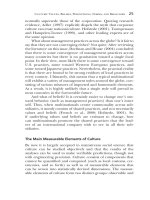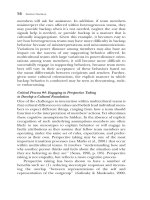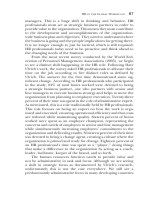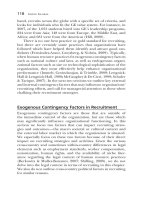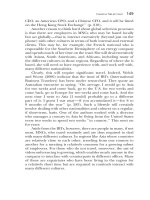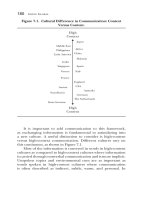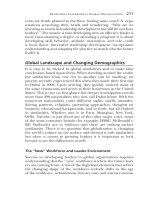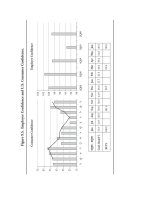Practical Applications and Recommendations for HR and OD Professionals in the Global Workplace_10 pptx
Bạn đang xem bản rút gọn của tài liệu. Xem và tải ngay bản đầy đủ của tài liệu tại đây (505.9 KB, 31 trang )
Figure 9.5. Employee Confidence and U.S. Consumer Confidence.
15
2
Ju
A
3
O
N
4
Ja
F
I
A
M
2
25
35
45
55
65
75
90
2Q08
Consumer Confidence
Employee Confidence
3Q08
4Q08
1Q09 2Q09
92
94
96
98
102
100
104
Jun Jul Aug Sep Oct Nov Dec Jan Feb
Mar Apr May Jun
2Q08
− 2Q09
Conf. Board %
51.0 51.9 56.9 59.8
38.8 44.9 38.0 37.7 25.3 26.0 39.2 54.8
49.3
ECI %
100.0
101.5
98.7
93.6
98.9
Strategic Surveying in the Global Marketplace 243
• Employee opinions about the future (company performance,
competitive standing, personal promising future, and so on)
reflect organizational vitality, as demonstrated by relationships
with a variety of economic health indicators (consumer
confidence, unemployment) and company financial metrics
(DEPS, TRR).
Enduring Survey Purposes
What is the real point of organizational surveys? Whatever the
specific angle of any given survey effort, survey programs are
intended to produce change. Perhaps more progressive systems
are designed to promote the discipline of change management,
of listening and responding to important constituents and feed-
back about organizational performance. In fact, they share this in
common with any measurement system (accounting systems, cus-
tomer surveys, quality audits, sales forecasts, six-sigma methods,
and so on).
Stepping back from surveys in particular, what are the com-
mon areas that organizations attempt to change? What are the
most common challenges companies face? To address this ques-
tion, many models of organizational effectiveness exist, from the
simple (Five Stages of Organizational Decline, Collins, 2009) to
the involved (for example, Burke-Litwin Model, Burke & Litwin,
1992), and the academic (Systems Model, Katz & Kahn, 1978) to
the applied (Balanced Scorecard, Kaplan & Norton, 1996; McKin-
sey 7 S Framework, Peters & Waterman, 1982) to the hybrid (High
Performance Model, Wiley & Brooks, 2000). Stepping back from
any single model, there appear to be five enduring challenges
that virtually any organization faces in its pursuit of growth and
financial sustainability or, more generally, vitality:
1. Customer Loyalty. Organizations seek to create value by pro-
viding customers—particularly paying customers—with valued
and competitive products and services.
2. Progressive Innovation. This reflects the creation of value
through refining and inventing future products and services.
3. Quality Work Processes. Products need to be efficiently created
and, along with services, effectively delivered.
244 Going Global
4. Engaged Employees. Organizations need to create an engaging
experience to encourage the most from the people who fuel the
processes, create the innovation, and deliver for the customers.
5. Clear and Compelling Leadership. The overarching mission
and direction of the organization needs to be developed and
translated through its leaders in order to properly secure and
align resources.
We do not present these five as the only challenges that an
organization may face. Certainly there can be crises of ethics, weak
financial discipline, regulatory issues, progressive sustainability
interests, and so forth. But these five reflect core challenges that
apply virtually universally to any organization.
The employee confidence case study illustrates one version of
slicing across these areas, touching particularly upon engagement,
leadership, and customer competitiveness. There is, in fact, a rich
history of research linking these topics to organizational climate
and performance. Recent reviews for each topic include Brooks
et al. (2006) for Customer Loyalty; Bledow, Frese, Erez, Anderson,
and Farr, (2009) for Innovation; Miron, Erez, & Naveh (2004) for
Quality; Macey and Schneider (2008) for Employee Engagement;
and Efron, Greenslade, & Salob (2005) for Leadership.
We argue that the vital organization is the one that can
focus on improving these disciplines, becoming a change-ready
organization, enabled to meet its challenges.
Organizational Ambidexterity
Each of the five challenges can be addressed on two levels:
maximizing currentperformanceand developing futurepotential.
For example, the Leadership challenge can involve enhancing
current leadership behaviors (for example, communication and
prioritization), as well as developing a succession plan for the
next generation of senior executives. Because no organization has
unlimited resources—whether those resources are money, talent,
or time—the appropriate balance, one leading to maximum
vitality, must be struck between current performance and future
potential. Table 9.3 provides examples of how each of the five
areas can have a current performance and a future potential
component.
Strategic Surveying in the Global Marketplace 245
Table 9.3. Enduring Challenges Involve Both Current
Performance and Future Potential.
Clear,
Compelling
Leadership
Quality Work
Processes
Engaged,
Confident
Employees
Progressive
Innovation
Loyal
Customers
Current
Perfor-
mance
Effective
Senior
Management
Quality,
Reduced Waste
Discretionary
Effort
Market Com-
petitiveness
Service
Future
Potential
Leadership
Development
Continuous
Improvement
Employee
Retention
Product
Pipeline
Customer
Retention,
Growth
The pursuit of maximizing current performance generally
involves streamlining systems, increasing scale, decreasing costs,
and other efforts to control and standardize the organization’s
efforts. The pursuit of developing future potential generally
depends less on control and more on creativity. The latter is
an inherently riskier endeavor. Thus, there is a built-in ten-
sion between exploiting current opportunities and exploring future
potential. The management of this tension is called organizational
ambidexterity (see, for example, O’Reilly & Tushman, 2004).
A full elaboration of organizational ambidexterity is bigger
than the scope of this chapter, but to summarize, it represents an
emerging organizational science of balancing priorities focused
on building efficiencies (process within a paradigm) against pri-
orities encouraging creative exploration (into new paradigms; see
Bledow et al., 2009). Though it may not impact a traditional sur-
vey program, any model of organizational effectiveness needs to
incorporate this tension, and perhaps new survey programs need
to take it into account.
Organizational Change and Resilience
Organizations are run by people, and people face challenges in
pursuing common goals and in their day-to-day efforts to enhance
performance. Striking just the right balance regarding how to
invest in organizational improvements—for example, choosing
between maximizing current performance and developing future
potential—is a chief concern with which organizations—and
246 Going Global
people—struggle. Being resilient in addressing these challenges
is a necessary component to maximizing the vitality of the
organization. As described below, resiliency is an organizational
characteristic as well as a personal attribute that, in conjunction
with balancing the resource allocations associated with maximiz-
ing current performance and future potential, would lead to
increased levels of organization vitality.
Measuring the organization on a global scale, as can be done
with employee confidence, is one effective way of predicting
and managing an organization’s future—in effect, to manage
organizational change. ‘‘The pace of change is quickening’’ is a
true statement, not just within an industry, geopolitical entity, or
by level of industrialization, but globally. How an organization
deals with change and its pace, both at an individual and at an
organizational level, will determine its long-term success. The old
notion that an organization can achieve long-term stability in its
customer base, product line, operating processes, or technology
is unrealistic if the organization is to thrive and cope with today’s
ongoing challenges. Today’s environment is more volatile than
ever and will remain so for the foreseeable future. Challenges will
become more and more ‘‘routine,’’ and responding effectively
to them will be a ‘‘normal’’ issue that organizations need to
be equipped to face. Organizations need to be able to cope
with challenges and to do so in a way that is sustainable and
does not limit future options. In fact, balancing the need to
drive performance in a definitive fashion while keeping future
options open are two goals that are somewhat in opposition.
Both are required for success (Berkes, Colding, & Folke, 2003).
Organizations that perform well in these areas as they deal with
their challenges will be by definition more resilient to threats and
will be exhibiting higher levels of vitality.
If a corporation aspires to perform as well as the market indexes
over the long term, it will have to change at the pace and scale
of the market, but without losing control. Companies, of course,
do not have to change at the pace and scale of the market, but
if they do not, then the research from McKinsey’s Long Term
Performance Database shows that they are more than likely to
underperform for their investors. [McKinsey & Company, 2009]
Strategic Surveying in the Global Marketplace 247
Resiliency is a construct that has generated increasing interest
since the 1990s and has been studied at the individual and organi-
zational level. Being resilient is the notion of positive adaptation
when faced with significant adversity or environmental threats
(Rutter, 1993). This definition implies that significant threats or
severe adversity are present and that the individual or organi-
zation positively copes with those threats. Being more resilient
rather than less has been shown to lead to positive outcomes for
both individuals and organizations (Cohn, Fredrickson, Brown, &
Mikels, 2009; Berkes, Colding, & Folke, 2003).
Vitality is the aggregation of resiliency measures and other crit-
ical metrics of organizational performance that, when tracked and
improved upon, enhances the organization’s ability to deal with
the increasing volatility seen in the organization’s environment.
Under normal conditions, the data suggest, an organization whose
vitality measures are appropriately designed, accurately measured,
and higher than the competition will not only achieve higherlevels
of resiliency but will also outperform that competition. It is impor-
tant to note that the vitality data represented by these concepts
have been found to be malleable, that is, changeable over time
if the correct measures are teamed up with appropriate change
processes. Protection from a loss of vitality and resilience does
not only involve the factors impinging at the moment, but rather
the way the organization deals with the ongoing and future risks
and threats—processes which are potential inflection points in
the organization’s life.
Being able to maintain the vitality of the organization and
its level of functioning when environmentally challenged will be
dependent on:
1. The level of the threat or degree of risk that the organization is
facing, including the performance of the organization on the
five common challenges cited earlier:
a. Customer loyalty
b. Progressive innovation
c. Quality work processes
d. Engaged employees
e. Clear and compelling leadership
248 Going Global
2. The organization’s response to the threat or risk and its ability
to turn that risk into opportunity
3. The appropriateness of the vitality measures that the organiza-
tion is tracking
4. The processes and mechanisms that the organization has in
place to maintain those vitality measures at a high level
Three broad areas—the environment within which the orga-
nization resides, the investments the organization is making, and
the achievements which the organization celebrates—contain six
key vitality processes which can be brought to bear to help address
the threats that the organization faces, including:
1. Environment
• Monitoring: Information collection or environmental
monitoring (for example, employee, customer and supplier
surveys, the gathering and analysis of other business
metrics).
• Reducing: Minimizing the occurrence of negative chain
reactions that can occur from one threat, before they spi-
ral out of control (for example, strong internal and external
communications networks).
2. Investment
• Warding: Investing in a shared vision, a shared operating
style, senior leadership, employees, products and services,
and quality—the standardization of those products and ser-
vices as well as organizational procedures.
• Transforming: Turning risks into opportunities by devel-
oping a culture of innovative and creating organizational
capabilities.
• Enhancing: Increasing organizational effectiveness and
efficacy (for example, cost control, state-of-the-art business
processes, contingency planning).
3. Achievement
• Celebrating: Celebrating and rewarding organizational and
personal accomplishments (for example, successful comple-
tion of goals; reward and recognition systems).
Strategic Surveying in the Global Marketplace 249
Overall a well-designed framework builds in a positive fashion
off outcomes traditionally cited as the marks of resiliency in a
person or organization, including reduced failure probabilities,
reduced consequences from failures, and reduced time to recov-
ery (Holling, 1973). Specific vitality factors have been linked to
increasing organizational performance (Brooks et al., 2006), and
the organization’s ability to achieve satisfied customers (Kendall,
2006). Though they should be tailored to each organization,
specific factors can include:
1. Having a confident, engaged workforce
2. Not taking success or customers for granted
3. Producing quality products and services that meet customers’
current needs
4. Delivering products and services with a customer service
orientation
5. Creating products and services with perceived value
6. Operating with a disciplined growth orientation
7. Implementing effective business processes
8. Having effective leadership
9. Ensuring the right people in the right jobs, overall
10. Developing a strong new product and service pipeline
11. Operating in a sustainable fashion
12. Operating with ethics and transparency
Measuring Vitality and Other Metrics
in a Globalizing World
Organizations work hard to maximize performance by increas-
ing their effectiveness. Efficiencies are strived for, the ability
to do more with less—and if at the same time the organiza-
tion can minimize risk to itself, that is just icing on the cake.
The complexity of these goals increases exponentially as the size
and complexity of the organization increases. Global organiza-
tions that need to deal with varied divisions or business units
spread across multiple countries—with unique cultures, political
situations, infrastructures, and so forth—face particularly chal-
lenging situations. Much research has been done to quantify the
250 Going Global
differences and the similarities that are apparent within the work-
force across various countries and cultures. Some of the research
seems to focus chiefly on the differences that exist (Hofstede,
1984), whereas others focus more on the similarities (Lundby &
Hui, 2008). But in many respects everyone is after the same thing:
increasing organizational effectiveness.
We can derive models that highlight our similarities or models
that highlight our differences, but the main question is, are we
collecting, monitoring, and analyzing information that makes a
difference in the performance for the organization under study?
That question is often answered by undertaking linkage studies,
where employee opinions are aggregated by work group or busi-
ness unit, and matched to various measures of performance (such
as customer satisfaction, financial performance) and then ana-
lyzed for impact. Though there are methodological approaches
to controlling for cultural or other geographic differences, this
kind of research is based on the notion that creating a simi-
lar measure of employee opinions across various countries and
cultures is in fact legitimate. One challenge that researchers of
organizational culture face is to determine whether broad, across-
the-globe measures of opinions are appropriate, and, in fact, if
they measure anything approaching the same constructs in differ-
ing societies. The questions emerge: Are we more similar when
it comes to how you measure attitudes or are we more different,
requiring perhaps a differing measurement instrument depend-
ing on where you happen to be located? Do individual differences
outweigh our ability to develop a uniform measure, or can well-
worded questions embedded within robust paradigms win out in
creating global measures of psychological constructs seen within
organizations?
As the case study presented earlier demonstrates, there can
be enough commonality across employee opinions aggregated at
a country level to result in significant and meaningful relation-
ships with changes in gross domestic product. Accommodating for
cultural differences would likely only improve upon this already
substantial relationship. For researchers and for organizational
leaders of global organizations, this is a fortunate and perhaps nec-
essary foundation.With some measures,like employeeconfidence,
more is better no matter where—or how—you live in the world.
Strategic Surveying in the Global Marketplace 251
This view is similar to emerging conclusions regarding cul-
tural influences in selection and assessment (J. Weekley, per-
sonal communication, 22 September, 2009). First, culture does
not change the important constructs to assess. Second, culture can
change the benchmarks or average scores to a degree (though
more for personality than for general mental ability). Third, the
validity of these constructs in predicting important performance
criteria appears comparable across cultures.
Though it may sound like an oxymoron, we human beings
are all fundamentally the same and yet all of us, each and every
one of us, is uniquely different. We are all human and our
humanness forces each of us to operate and experience the world
within the evolutionarily derived boundaries of Homo sapiens. Yet
what we celebrate (or perhaps should celebrate) most about our
humanness is our individual differences and the freedom we have
to make choices, which together yield an infinite number of ways
in which we can express our humanity. We all may have a unique
fingerprint, but we all have fingerprints.
Some of us choose to work in health care, others plant crops,
some sell goods or services, others teach, drive a taxi, work in
construction, practice law, become an accountant, sing on a stage,
play sports, operate a business, or a whole host of other activities.
Some of us prefer to live in urban environments, whereas for
others only rural will do. Some of us prefer to travel and others
are homebodies, perhaps even living within a few miles of where
they were born. Some of us take comfort in being religious
and others are not religious. Some get married, perhaps having
children, and others prefer to stay single. The great majority of
us will have opinions and ideas throughout our lives that will be
strongly shaped by the cultures and societies in which we grew
up, the experiences we had—and our choices will be influenced
accordingly.
As we make those choices we are creating a unique set of
outcomes that helps to define ourselves. For instance, look at the
rural construction worker who married his high school sweetheart,
has three kids and a dog, and likes to travel to new places each time
the family takes a vacation. That is a combination of characteristics
that is accumulated over the course of one’s life that helps to
differentiate each and every one of us from the others. However,
252 Going Global
as we pick and choose between the enormous numbers of choices
thatarepossibleasweexperienceourlives,weareallinpursuit
of the same thing. We have the expectation that should we be
able to achieve our goals, whether they are to work in health care,
construction, plant crops, travel, or to get married and have kids,
that somehow we will be happier. We make these choices and live
our lives in the pursuit of happiness, an underlying fundamental
of our humanity. When people feel that they have no or few
options available to them they tend toward depression, and one
intervention to assist those who feel like they have few options is
to help them understand the choices that they do in fact have
(Wake & Miller 1992).
Defining ourselves, our organizations, or our societies by focus-
ing on the sameness that exists between them is both illusory and
real, as it is focusing only on their uniqueness that defines them. It
is illusory for we, our organizations, and our various societies are
clearly not the same. Butit is real in that they all have shared under-
lying characteristics. The richness that describes the diversity of
humanity, or our lack of sameness, yields a more robust humanity,
with individuals bringing differing experiences, knowledge, skill
sets, characteristics and abilities, and with differing cultures and
societies contributing uniquely to the powerful mix. But we would
defy you to find a worker anywhere in the world, of any generation
or any other demographic you would care to choose, who did
not want to be treated respectfully and in a dignified fashion, or
want to feel valued, with a sense of accomplishment springing
from their efforts, a sense of fairness of treatment with respect to
equity, and pride in their organizations and themselves. And one
who would not want to have confidence in the future of his or her
organization. We could go on describing other shared character-
istics of workers, but the point is simply that a large number of
commonalities do in fact exist.
As we measure ourselves and our organizations from a
characteristics standpoint, do we focus on our similarities, our
differences, or do we somehow attempt to measure both? Is it
legitimate to use the same measures of employee satisfaction or
loyalty, and so on in a highly industrialized country with a high
standard of living as it is in a country under the constant threat
of famine, disease, war, or terrorism? We have argued that we
Strategic Surveying in the Global Marketplace 253
humans are both similar and different. We further contend that
our similarities make it possible to create a measurement with
enough robustness to work across the wide spectrum of situations
in which organizations are enmeshed.
As great an impact as globalization has had so far, the people
of the world today are not homogenous culturally, economically,
politically, or demographically. And by extension the organi-
zations that operate in a global fashion are not homogenous,
culturally, economically, politically, or demographically either.
Organizations that operate globally work to maximize their per-
formance across a wide variety of cultures, economic conditions,
political systems, and demographic characteristics of the local pop-
ulations. It is a challenge. Many of these multinational, multicul-
tural, multipolitical, and multidemographic organizations, intheir
attempt to assess their organizational cultures, use standardized
measures across their internal organizational components—and
this raises a question. By doing this are they measuring the simple
fact that each of these divergent components has fingerprints, or
are the standard measures and the methodologies employed with
them sensitive enough to capture the unique characteristics of
each fingerprint within the organization? What is lost and what is
gained in this approach?
Conclusion
Global, multinational surveys are difficult. But they are simply a
microcosm of all efforts designed to respond to organizational
challenges and to improve organizational functioning in some
way. With this in mind, the major themes of this chapter can be
wrapped up in a handful of key points:
• Organizational surveys, perhaps especially those in large, global
organizations, need to drive toward improving effectiveness.
• Accordingly, the purpose of surveys is not to characterize dif-
ferences in work climate or culture. There is no denying the
impact of culture. However, it is more important to focus on the
common ‘‘something’’ that the organization pursues.
• Thus, a survey strategy, if truly strategic, is part of a larger orga-
nizational change strategy, one that maps into the five enduring
254 Going Global
challenges reflected by leadership, quality processes, employee
engagement, innovation, and customer loyalty. Employee confi-
dence provides one example of such a measure.
Thinking of surveys in this way parallels the evolution of
Human Resources, with the ongoing efforts of HR professionals to
become increasingly strategic business partners. HR interests and
objectives are more and more defined first by the needs of their
line management clients and second by their human resources
functional requirements (Vosburgh, 2007). As mentioned in the
introduction, vitality is the ‘‘capacity for survival or for the con-
tinuation of a meaningful or purposeful existence,’’ and thereby
reflects this notion of starting with the end in mind. Building
this capacity is about nurturing the overarching disciplines of
resiliency and ambidexterity.
References
Berkes, F., Colding, J., & Folke, C. (2003). Navigating social-ecological
systems. Cambridge: Cambridge University Press.
Bledow, R., Frese,M., Erez, M.,Anderson, N., & Farr, J. (2009).A dialectic
perspective on innovation: Conflicting demands, multiple path-
ways, and ambidexterity. Industrial and Organizational Psychology:
Perspectives on Science and Practice, 2, 305–337.
Brooks, S. M., Wiley, J. W., & Hause, E. L. (2006). Using Employee and
Customer Perspectives to Improve Organizational Performance.
In L. Fogli (Ed.), Customer service delivery: Research and best practices.
San Francisco: Jossey-Bass.
Burke, W. W., & Litwin, G. H. (1992). A causal model of organizational
performance and change. Journal of Management, 18, 523–545.
Cohn, M. A., Fredrickson, B. L., Brown, S. L., & Mikels, J. A. (2009).
Happiness unpacked: Positive emotions increase life satisfaction by
building resilience. Emotions, 361–367.
Collins, J. (2009). How the mighty fall. New York: Harper Collins.
Dictionary.com. (2009). Definition of ‘‘Vitality.’’ Retrieved from
/>Efron, M., Greenslade, S., & Salob, M. (2005). Growing great leaders:
Does it really matter? Human Resource Planning, 28, 18–23.
Hofstede, G. (1984). Culture’s consequences: international differences in work-
related values. Thousand Oaks, CA: Sage.
Holling, C. (1973). Resilience and stability of ecological systems. Annual
Review of Ecology and Systematics, 1–23.
Strategic Surveying in the Global Marketplace 255
Kaplan, R. S., & Norton, D. P. (1996). Translating strategy into action: The
balanced scorecard. Boston: Harvard Business School Press.
Katz, D., & Kahn, R. L. (1978). The social psychology of organizations
(2nd ed.). New York: Wiley.
Kendall, S. (2006). Customer service from the customer’s perspective.
In L. Fogli (Ed.), Customer service delivery: Research and best practices.
San Francisco: Jossey-Bass.
Lundby, K., & Hui, H. (2008). Employee engagement across Asia Pacific:
Same or not the same? In M. Battista (Chair), Associate engage-
ment in Asia—Myth or mystery? Symposium/forum presented at the
Twenty-third Annual Conference of the Society for Industrial and
Organizational Psychology, San Francisco, CA.
Macey, W. H., & Schneider, B. (2008). The meaning of employee
engagement. Industrial and Organizational Psychology: Perspectives on
Science and Practice, 1, 3–30.
McKinsey & Company. (2009, June 15). Managing in turbulent times, the
pace of change. Retrieved June, 2009, from McKinsey & Company:
www.mckinsey.com/ideas/MITT/paceofchange/index.asp.
Miron, E., Erez, M., & Naveh, E. (2004). Do personal characteristics
and cultural values that promote innovation, quality, and efficiency
compete or complement each other?Journal of Organizational Behav-
ior, 25, 175–199.
O’Reilly, C. A., III, & Tushman, M. L. (2004). The ambidextrous organi-
zation. Harvard Business Review, 82, 74–81.
Peters, T. J., & Waterman, R. H. Jr. (1982). In search of excellence: Lessons
from America’s best-run companies.NewYork:Harper&Row.
Rutter, M. (1993). Psychosocial resilience and protective mechanisms. In
J. Rolf, Risk and protective factors in the development of psychopathoplogy
(pp. 181–212). Cambridge: Cambridge University Press.
Saltzman, J. M., & Herman, A. (2009). Understanding employee confidence
in today’s environment: 3Q09 Invited presentation delivered at the Fourth
Annual Kenexa World Conference. Dallas, TX.
Schneider, B., Parkington, J. J., & Buxton, V. M. (1980). Employee
and customer perceptions of service in banks. Administrative Science
Quarterly, 25, 252–267.
Vosburgh, R. M. (2007). The evolution of HR: Developing HR as an inter-
nal consulting organization. Human Resource Planning, 30, 11–23.
Wake, M. M., & Miller, J. F. (1992). Treating hopelessness. Clinical
Nursing Research, 347–365.
Wiley, J. W., & Brooks, S. M. (2000). The high-performance organiza-
tional climate: How workers describe top-performing units. In N.
S. Ashkanasy, C. Wilderom, & M. F. Peterson (Eds.), The handbook
of organizational culture and climate, (pp. 177–191). Thousand Oaks,
CA: Sage.
CHAPTER 10
Best Practices for Training
Intercultural Competence
in Global Organizations
Jessica L. Wildman, Luiz F. Xavier,
Mitch Tindall, and Eduardo Salas
Consider the following set of facts regarding global business:
research findings indicate that between 16–40% of expatriate
managers end their foreign assignments early, often due to poor
performance or an inability to adjust to foreign environments
(Black & Mendenhall, 1990; Rahim, 1983). Even if expatriates stay
the length of their assignment, oftentimes their assignment can be
viewed as a failure because of lost opportunities, delayed produc-
tivity, or damaged relationships (Bennett, Aston, & Colquhoun,
2000; Littrell, Salas, Hess, Paley, & Riedel, 2006; Selmer, Torbiorn,
& Leon, 1998). With the direct cost of sending expatriates to their
foreign assignments as high as $220,000 (Birdseye & Hill, 1995),
having a substantial proportion of expatriate assignments failing
can cost organizations substantially. For example, it has been esti-
mated that each failed expatriate assignment costs organizations
between $50,000 and $150,000, with cumulative annual costs of
expatriate failures totaling around $2 billion for U.S. organiza-
tions (Copeland & Griggs, 1985; Harris & Moran, 1979; Misa &
Fabricatore, 1979). Furthermore, even if the expatriate assign-
ment is successfully completed, a large proportion of expatriates
leave the organization within a year of returning to their native
country because they have difficulty readjusting to U.S. life and
culture (Gomez-Mejia & Balkin, 1987).
256
Best Practices for Training Intercultural Competence 257
As workforce globalization increases, intercultural experiences
such as expatriate assignments are becoming more commonplace.
The grim state of expatriate assignments just described highlights
the growing need for effective cultural interventions. Encourag-
ingly, there has been an increased focus in both science and
practice on improving the quality of intercultural interactions
(Byram, 1997; Deardorff, 2009; Hall, 1992; Landis, Bennett, &
Bennett, 2004). Many organizations are now using training pro-
grams to make their employees more ‘‘culturally competent’’
before sending them abroad. Intercultural competence training
is often touted as a method of increasing the success of expatriate
assignments and repatriation. Holtbr¨ugge and Schillo (2008) fur-
ther argue that intercultural training has the potential to benefit
not only expatriates and others in face-to-face intercultural situa-
tions, but also virtual delegates interacting with people from other
cultures.
Despite an increase in intercultural training use, there is very
little consensus in both science and industry regarding what inter-
cultural competence actually entails or the best way to train for it.
Moreover, organizations tend to use any training intervention they
can get their hands on without a clear understanding of why and
how to most effectively implement them. Therefore, this chapter
is aimed at providing practical guidance regarding the training of
intercultural competence in employees of global organizations.
The chapter will take four main thrusts toward this goal. First,
we describe intercultural competence and the various constructs
that can be considered part of intercultural competence. Second,
we delineate several extant intercultural competence training
approaches that have grown out of organizational science. Third,
we look at the criticality of proper training assessment, and
directly apply the science of training assessment to the arena
of intercultural competence training. Finally, we integrate the
previous sections into several best practices for global organiza-
tions that desire to train their employees effectively in intercultural
competence.
What Is Intercultural Competence?
Before we can discuss how to most effectively train toward
intercultural competence, it is necessary to clearly define intercul-
tural competence as a construct. Some have defined intercultural
258 Going Global
competence as skills that allow an individual to be sensitive to
interpersonal dynamics, be perceptive to complex interactive sit-
uations, and be able to control their emotions (Lonner & Hayes,
2004). Others have described intercultural competence simply
as the ability to function effectively in another culture (Gertsen,
1990). This latter broad description of intercultural competence
allows for a wide variety of knowledge and skills to be considered
that can contribute to an employee’s intercultural competence.
Accordingly, our chapter adopts this broad approach to the con-
ceptualization of intercultural competence by discussing a variety
of skill sets that could potentially contribute to an individual’s
success in intercultural situations. Restated, we adopt Gertsen’s
(1990) broad definition of intercultural competence as the ability
to function effectively, and consequently include several the-
oretical constructs considered to be integral to success in an
intercultural context. In the following sections, emotional intelli-
gence, social intelligence, adaptability, and perspective taking are
introduced as the critical skill sets that make up intercultural com-
petence. Finally, cultural intelligence is introduced as the newest
theoretical development in the arena of intercultural training.
Emotional Intelligence
Emotional intelligence is a set of skills focused on self-awareness,
impulse control, and empathy (Goleman, 1998). This includes
the ability of individuals to perceive and respond appropriately to
the affective states of culturally similar others, as well as to self-
regulate their own emotions. Thomas (2006) defines emotional
intelligence as ‘‘the ability of people to perceive the emotional
states of others and to regulate one’s own emotional state in
the service of improved interactions’’ (pp. 79–80). As Earley
and Peterson (2004) state, this particular competency, as defined
by the literature, assumes that individuals are interacting with
others that are culturally similar to themselves. Simply stated, an
individual who is emotionally intelligent in their own cultural
context may or may not be effective at perceiving and responding
to the emotional cues of others when placed in a cross-cultural
context. However, emotional intelligence is critical to effective
interaction in any social context, including intercultural ones,
and therefore is an important facet of intercultural competence.
Best Practices for Training Intercultural Competence 259
Social Intelligence
Social intelligence is a set of skills focused on getting along
smoothly with others around us (Cantor & Kihlstrom, 1987).
Marlowe (1986) developed a model of social intelligence com-
prising four core components: social interest, social self-efficacy,
empathy skills, and social performance skills. Social interest refers
to an individual’s concern for others. Social self-efficacy refers to
an individual’s feelings of confidence in social situations. Empathy
skills include the ability to both cognitively and affectively under-
stand others, and social performance skills are the observable
social behaviors that an individual engages in. Again, though this
set of competencies is critical for individuals performing in any
social context including intercultural situations, it lacks any direct
acknowledgment of culture in those situations. It is possible that
a socially intelligent individual may be very effective at respond-
ing to social situations in his own culture while being completely
confused in a cross-cultural context. However, an individual who
is socially intelligent in intercultural contexts will likely be more
successful than a socially unintelligent individual, making social
intelligence another necessary, but insufficient, component of
overall intercultural competence.
Adaptability
Adaptability is another individual attribute that has been
associated with overseas success (Zakaria, 2000). Adaptability in
the workplace has been broken down into several basic job-related
skills: solving problems creatively, dealing with uncertain work
situations, learning new tasks, demonstrating interpersonal
adaptability, demonstrating cultural adaptability, demonstrating
physical adaptability, handling work stress, and handling
emergency situations (Pulakos, Schmitt, Dorsey, Arad, Hedge,
& Borman, 2002). In other words, to the extent that workers
are able to perform these skills, they will be more effective
in intercultural contexts. Adaptability has been discussed in a
variety of organizational contexts, including the context of global
organizations where employees are required to quickly adapt to
new cultures. Adaptability has been shown to be an important
attribute for someone interacting in a multicultural setting.
260 Going Global
A person who is easily able to adapt to a new situation should
have less difficulty adjusting in a multicultural setting, compared
with someone who is less flexible.
Perspective Taking
Perspective taking is a skill that has been defined in several dif-
ferent ways. According to Whaley and Davis (2007), perspective
taking consists of cognitive flexibility or problem-solving skills.
Galinsky and Moskowitz (2000) define perspective taking as the
ability to embrace the perspective of another person. In the field of
counseling and clinical psychology, perspective taking is seen as an
integral attribute of a culturally competent mental health service
provider (Lopez, 1997) and vital to appropriate social function-
ing (Galinsky & Moskowitz, 2000). McAllister and Irvine (2000)
suggest that gaining an understanding of others’ perspectives is
a critical aspect of cross-cultural learning. Perspective taking has
been found to be positively correlated with social competence
and self-esteem (Davis, 1983). According to McAllister and Irvine
(2000), during the final stage of becoming interculturally sensi-
tive (integration), a person is able to analyze phenomena from a
different perspective or within the cultural context. Consequently,
someone who is able to actively take the perspective of another
will have a better understanding of that person’s behavior and, in
turn, will be able to relate with that individual to a larger degree.
Therefore, one’s level of perspective taking can be considered
another skill set critical to being successful in an intercultural
work setting.
Cultural Intelligence
Cultural intelligence (CQ) is a concept developed in response to
the lack of attention paid to culture in other concepts such as emo-
tional and social intelligence. Earley and Peterson (2004) point
out that emotional intelligence and social intelligence, though
clearly relevant, are void of a cultural context in terms of explain-
ing how and why people behave as they do. CQ can be described as
a ‘‘multifaceted competency consisting of cultural knowledge, the
practice of mindfulness, and the repertoire of behavioral skills’’
Best Practices for Training Intercultural Competence 261
(Thomas & Inkson, 2004, pp. 182–183). This set of knowledge and
skills allows individuals to interact effectively across a multitude of
cultural situations. Some have described CQ as having four basic
components: meta-cognition, cognition, motivation, and behavior
(Crowne, 2008). Meta-cognition is an individual’s knowledge of
and control over their different cognitions (Ang, Van Dyne, &
Koh, 2004). Cognition is an individual’s knowledge of self and
social environment, and in terms of CQ, it also includes the knowl-
edge about the structures of a given culture. Motivation refers to
an individual’s genuine interest and desire to learn and function
in cross-cultural situations. Finally, behavior refers to a person’s
ability to exhibit the appropriate verbal and nonverbal behaviors
when placed in a cross-cultural situation. This may also include
the ability to refrain from engaging in inappropriate behaviors.
In a more practically oriented interpretation of the concept,
Earley and Mosakowski (2004) suggest that there are three basic
sources of cultural intelligence: head, body, and heart. In other
words, individuals must first devise learning strategies for acquir-
ing new knowledge when in a cross-cultural situation (head).
Second, they must learn to mirror the customs and gestures of a
particular culture (body). Finally, an individual will never become
culturally intelligent unless they are truly motivated to do so and
confident in their ability to learn (heart). This approach is a
much more practically oriented system aimed at helping profes-
sionals to be more behaviorally effective in cross-cultural business
situations.
Thomas (2006) adopts the Earley and Ang (2003) definition
of cultural intelligence, which is the ability to interact effec-
tively with people from other cultures. However, Thomas goes
on to offer a revised three-pronged approach to developing CQ
that includes knowledge, mindfulness, and behavior. Knowledge
includes an individual’s basic understanding of culture and cross-
cultural interactions in general. Mindfulness is a process linking
knowledge and action. More specifically, mindfulness is a height-
ened awareness of and attention to current experience or reality.
This component of CQ suggests that culturally intelligent indi-
viduals are constantly aware of their cultural surroundings, as
well as their own assumptions and thoughts regarding those sur-
roundings. Finally, behavior is the ability to choose and enact
262 Going Global
culturally appropriate behaviors based on the specific cultural
context.
The term cultural intelligence has also been used in a more
general sense to describe people’s overall success when attempting
to adjust to another culture (Brislin, Worthley, & Macnab, 2006).
This very broad understanding of cultural intelligence is similar to
the broad understanding of intercultural competence mentioned
previously. It has been suggested that cultural intelligence, regard-
less of which particular set of competencies is considered, can be
increased through experience, practice, and a positive attitude
toward learning (Brislin et al., 2006). For the remainder of the
chapter, in an effort to be as comprehensive as possible, we do not
limit our discussion to any one of these theoretical approaches,
but instead describe a variety of training programs and strate-
gies aimed at improving the effectiveness of intercultural work
interactions via any of the skills mentioned here.
Current Intercultural Competence
Training Approaches
Intercultural competence training can be described as any formal
effort toward ‘‘preparing people for more effective interpersonal
relations and for job success when they interact extensively with
individuals from cultures other than their own’’ (Brislin, Cushner,
& Yoshida, 1994, p. 183). Similarly, Littrell and colleagues (2006)
define intercultural competence training as an ‘‘educative pro-
cess used to improve intercultural learning via the development
of cognitive, affective, and behavioral competencies needed for
successful interactions in diverse cultures’’ (p. 356). Gudykunst
and Hammer (1983) developed a typology for classifying various
intercultural training approaches based on two core criteria: the
training method and the training content. Training methods can
be described as either didactic or experiential, whereas train-
ing content can be culture general or culture specific. Didactic
training, for the most part, tends to be primarily culture spe-
cific, whereas experiential training is often focused on developing
culture-general skills. In the following sections, we briefly describe
the current approaches for training intercultural competence,
including didactic, experiential, and mixed approaches.
Best Practices for Training Intercultural Competence 263
Didactic Training Approaches
Didactic training refers to any training intervention that focuses
on information giving. In other words, didactic training is usually
what most people imagine when they think of training: classroom-
based lectures, readings, assignments, and quizzes. Kealey and
Protheroe (1996) identify three types of didactic cross-cultural
training: practical information, area studies, and cultural aware-
ness training. Practical information training is one of most
common types of cross-culture training used in industry and is
focused on providing information regarding the living conditions
of a culture such as travel arrangements, shopping, appropriate
attire, and the realities of the job (Kealey & Protheroe, 1996). Area
studies provide trainees with information regarding the history,
values, economy, and political structure of the culture in which
they will be living. Information is usually conveyed either through
self-directed reading, audio or video files, or in-person lectures.
Oftentimes practical information training and area studies are
combined and given simultaneously. Cultural awareness train-
ing takes a less information-based approach than the others; it
attempts to get trainees to see and feel things from the perspective
of host nationals. The most common, validated, and well-known
cultural awareness training intervention is known as the culture
assimilator. Because the culture assimilator is often the bench-
mark by which other cross-culture interventions are evaluated, it
is discussed in further detail.
The culture assimilator is a training intervention that is
designed to expose members of one culture to the basic con-
cepts, attitudes, role perceptions, customs, and values of another
culture in a time span of two to five hours (Fiedler, Mitchell, &
Triandis, 1971). The specific content of culture assimilators can
vary but typically include information regarding the other cul-
ture’s customs and values. Traditionally, culture assimilators are
culture specific, with culture assimilators having been developed
for Iranian, Thai, Honduran, and Greek culture (Fiedler et al.,
1971). More recently, however, culture-general assimilators have
been developed that focus on how cultures, across the board, vary.
A culture assimilator is first developed by having host nationals
and expatriates with experience in the other culture identify criti-
cal incidents that occur on the job. These subject-matter experts
264 Going Global
are asked to describe a work incident in which an expatriate inter-
acted with a host national but misinterpreted or was confused
by the actions or reactions of a host national. Ideally, a critical
incident should be easy to interpret once a person has sufficient
knowledge of the culture. When a sufficient number of critical
incidents have been gathered, the incidents are developed into
training scenarios. Trainees typically go through culture assimi-
lators at their own pace. Trainees read each scenario describing
a multicultural work incident and select one of four possible
responses. Each response is accompanied with feedback that pro-
vides the trainee further information regarding the culture. If the
trainee selects an incorrect answer, she is asked to select another
answer until she gets the correct answer.
Brislin, Cushner, Cherrie, and Young (1986) developed a
culture-generic assimilator consisting of critical incidents cover-
ing themes such as anxiety, disconfirmed expectations, time and
space, roles, language, and in-group or out-group distinctions.
Theory-based cultural assimilators have also been recently devel-
oped (Bhawuk, 1998; 2001); these assimilators integrate cultural
theories into the training material in order to provide trainees
with a guiding framework. For instance, the cultural dimension of
individualism and collectivism has been used to develop a cultural
assimilator. Trainees learn about individualism and collectivism
and are taught the importance of understanding these concepts
when evaluating the behaviors of individuals from other cultures.
Culture assimilators have been used to train American human-
itarian aid volunteers, military officers, and civilian advisors for
overseas operations in Honduras, Thailand, and Greece. Across
these diverse groups and cultures, culture assimilators have been
found to be quite effective at improving job performance and
interpersonal adjustment overseas (Fiedler et al., 1971; Worchel
& Mitchell, 1972).
Experiential Training Approaches
Experiential training consists of training interventions that involve
learning by doing. The focus is on gaining experience in inter-
cultural situations rather than just listening to lectures or reading
about other cultures. A common theme linking various expe-
riential intercultural competence training interventions is that
Best Practices for Training Intercultural Competence 265
trainees participate in activities that they are likely to face in other
cultures. The primary goal of experiential training is to develop
and practice skills that will enable employees to interact more
effectively with host nationals. A secondary goal of experiential
training is to help trainees to see things and interpret situations
from the host culture’s point of view (Littrell & Salas, 2005).
Common experiential cross-cultural training interventions
include role playing and simulations (Littrell et al., 2006). Role
playing usually requires trainees to act out fictional intercultural
business situations. One particular intercultural simulation, the
BaF´aBaF´a simulation created by Simulation Training Systems
(Summers, 2004), has trainees divide into fictional cultures and
then walks them through interactive scenarios designed to make
them more aware of how culture influences behavior in orga-
nizations, and how to most appropriately interact with people
from other cultures. Royal Dutch Shell utilizes a similar inter-
cultural simulation known as ‘‘Cultural Detective’’ that provides
face-to-face as well as online interactive role-playing situations for
their employees (Rodriguez, 2009). Overlaps (that is, on-the-job
training) can also be considered a form of experiential training.
Trainees taking part in overlaps work closely with an experi-
enced expatriate in-country who fills the trainee in on both work
practices and adjusting to the culture.
Behavior modification training is yet another form of expe-
riential training. This training is based on social learning theory
and has four components: attention, retention, reproduction, and
incentive (Bandura, 1977). Trainees first observe examples of
effective behaviors and then practice the observed behaviors.
Trainers provide positive reinforcement and constructive
feedback to ensure that trainees perform culture-appropriate
behaviors. Incentives such as rewards and motivation help ensure
that trainees attend, retain, and reproduce trained behaviors.
Behavior modification training for intercultural competence in
particular consists of having trainees learn and practice culture-
appropriate behaviors and avoid culture-inappropriate behaviors.
Mixed Training Approaches
Some intercultural training interventions contain elements of
both didactic and experiential training and therefore can be
266 Going Global
categorized as mixed training approaches. For example, GoldStar
Electronics Corporation of South Korea has implemented an inte-
grated cross-cultural training program that is focused on providing
trainees with cultural information as well as practical exposure to
common intercultural situations (Montagno, 1996). Three such
mixed training interventions that will be discussed in greater
detail are language training, integrated cultural assimilator and
behavior modeling training, and relational ideology training.
Language trainingisconsidered separately from othertraining
methods because it often includes both didactic and experiential
elements. That is, trainees are provided with rote information and
knowledge about the language and culture, but also actively prac-
tice speaking the language as well. Language training consists of
teaching trainees the language of the host country. In practice, the
success of language training varies depending on the complexity
of the language being taught, the methods for teaching, and indi-
vidual differences in the trainees. For example, tonal languages
like Japanese or Thai are much harder to learn for speakers
who natively speak nontonal languages like English or French.
Immersion classes are often more effective than other approaches
becausetheyforcethestudentstoengagemorefullyintheuse
ofthelanguage.Andfinally,somepeoplearejustmoreadept
than others at learning new languages. Therefore, language train-
ing may be more useful as a supplemental intercultural training
approach than as a stand-alone intervention.
Harrison (1992) developed an integrated training program
that incorporated both cultural assimilators and behavioral mod-
eling training. On the first day, trainees received an overview of
the training program and were given a culture assimilator con-
sisting of 60 critical incidents to complete at their own pace. The
next day, trainees were given the behavioral modeling training
which consisted of trainees (1) learning key principles, (2) view-
ing a film of a person utilizing key principles, (3) practicing key
principles in role plays, and (4) receiving reinforcement from
trainers and other group members. The two approaches comple-
ment each other as the culture assimilator allows for the trainees
to be exposed to a wide variety of cultural critical incidents, and
the behavioral modeling training allows for direct practice of
culturally competent skills.


